Five to Stay Alive  Via Brown's Guides Via Brown's Guides Earlier this month, an outdoors website by the name of Brown’s Guides started a promotion titled: “Gear I Can’t Live Without.” The website, whose mantra is “Great gear inspires great experiences,” asked its Twitter followers to briefly describe a piece of gear that they could not live without and explain why. Since it has nearly 4,000 Twitter followers the responses were varied and numerous. Some described a favorite piece of clothing, or a small luxury item. Others interpreted it as an item vital to survival – meaning that if you only had one or two items in a survival scenario, what would they be? I fell in the latter school of thought. While a few of my suggestions did get used during the promotion, it inspired me to make a list of the five items that I would choose to have with me if I could only have five items in the wilderness. So I chose these items out of my gear bag to meet what I think are the most basic needs: water, food, shelter, protection and direction.
 1. Ka-Bar Full Sized Utility Knife Ka-Bar knives hit the jackpot when they received the contract to make the standard issue combat knifes for the U.S. Marines during WWII. Almost 75 years later, they still have the contract due to the suburb quality of their products. This knife can provide the peace of mind that is so crucial to any survival scenario, and can also be used as a hammer, hatchet or harvester of edibles.
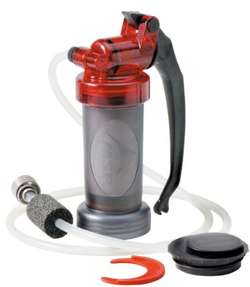 2. MSR Miniworks EX Microfilter Clean, potable water is by far the most important resource in the wilderness. There are very few places in the world I would feel safe drinking untreated water from the source. In fact, Giardia and Cryptosporidium have found their way into almost every stream, river, lake and pond in North America. Normally, I prefer the old-fashioned boiling method, but I always have backups. In this scenario I feel like I would need a reliable, sturdy water filter that can provide me with fast, clean drinking water without wasting energy.
 3. Firesteel 1,200 Strike Fire Starter
Aside from water and food, a good fire will do more for your psyche than anything else. Normally, I use my UCO waterproof matches, and adhere to the “one match, one fire” philosophy, but in a
survival scenario even “one match, one fire” will only get you so many fires. While it may be considerably harder to start a fire with one of these without practice, it can provide an indefinite number of fires while awaiting rescue.
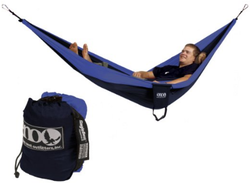 4. Eagle’s Nest Outfitters Hammock
I enjoy sleeping in this tent in the best of conditions, whether it be at home, at the park or on the trail, but in a survival scenario a light, comfortable shelter is invaluable. The normal setup of tent, sleeping bag, and pad only work when they are together. It would be hell to sleep on the ground without a pad and bag, and an exposed sleeping bag is an open invitation to all sorts of unwanted nighttime visitors. This off-the-ground shelter can help get the good night sleep that is vital to keeping up one’s strength.
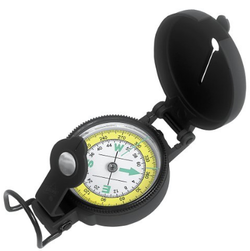 5. Silva Lensatic 360 Compass
It is not the fanciest compass in my gear bag, but it is the sturdiest. With a full pack, something that is compatible with a topo map would work much better. However, in this scenario I would consider a topo map another item. While it does have a sighting unit, it folds up compactly, and its aluminum body won’t smash if you drop it. Well it may not be pretty, but I would like to think that I would be able to make it with just these five items. However, this is just my opinion, feel free to share your “Top Five to Survive” in the comment section. Special thanks to Brown’s Guides for the mentions, those interested in letting them know about any “Gear I Can’t Live Without” can contact them here.
Ultralight meets ultra-convenient  Sheri and Randy Propster Sheri and Randy Propster As one year winds down, and a new one is on the horizon, many outdoor companies use this time to unveil their latest products and upgrades to a customer base that is chomping at the bit for Mother Nature to flip the switch back to spring. For the past seven years, Sheri and Randy Propster have been traversing the country as a part of Backpacker magazine’s “ Get Out More Tour.” While in college, they went on a hiking trip to the Blue Ridge Mountains in Virginia that would spark a shared passion for the outdoors that culminated with their marriage and a 4,200 mile thru-hike of the American Discovery Trail for their honeymoon. Now, they share their love of the outdoors with the public by touring the country for Backpacker to encourage people to spend more time in the outdoors. This November, the Propsters came to the Germantown Avenue location of Outdoors Inc. as a part of their tour. Here are some highlights of the latest gear they were presenting.
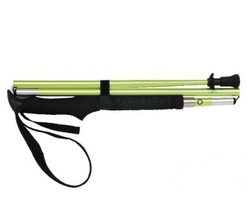 Helinox trekking pole Passport Series Helinox trekking pole Passport Series Hellinox Trekking Poles: Passport Series “I call trekking poles an instant upgrade. One of my favorite studies was done by a research scientist who determined that four points of contact changes the distribution of weight so much so that on a level surface you take 11 pounds, or more off of the pressure on your lower legs every step you take, and on an incline or decline you’re removing up to 24 pounds, or more. So if I gave you 11 ounces to take away 11 pounds; that’s a backpacking no-brainer.”
– Randy Propster
Helinox is a relative newcomer to the trekking pole market, but its parent company DAC is well-known for making surprisingly sturdy tent poles out of ultra-lightweight alloys. Earlier this year, they decided to apply their custom alloys to trekking poles, and the result was Helinox. They offer three series of poles, the Causeway, the Ridgeline and the Passport. The latter is a favorite among ultralight backpackers, because each pole collapses down, in a similar fashion to a tent pole, to a mere 13.8 inches, weighs 5.5 ounces and is shockingly durable.
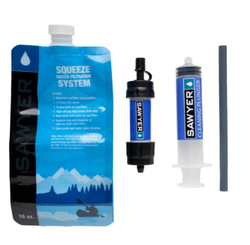 Sawyer Squeeze Filter Sawyer Squeeze Filter Sawyer Squeeze Filter “The internal workings of this filter were designed in the medical field for kidney dialysis. They utilized the .1 micron hollow fiber core to clean blood, but
recreationally, it cleans water just as effectively. Anything passing through
this side can’t get through if it is bigger than .1 micron, so it will eliminate
bacteria, protozoa, cryptosporidium, Giardia or anything that we would need to
be worried about from our water supply.”
–Randy Propster
This small filtration device is not the first of its kind, but with its 3 ounce pack weight and its interchangeable system of hoses and bags, it is one of the most convenient. It comes with three attachable bags of varying size that can be filled up from the source and filtered through the device into your container of choice. The system works so efficiently that kayakers or canoeists are able to use the device to drink directly from the source without even stopping. Unlike most systems, the filter does not require replacing and comes with a million gallon guarantee.
 PowerTraveler SolarMonkey Adventurer PowerTraveler SolarMonkey Adventurer PowerTraveler SolarMonkey Adventurer
“One of the questions that we have gotten the most over the years is: ‘How do we keep our electronics charged?’ When this is fully charged we can let our iPhone drain down to zero percent, and just by the internal battery we can charge it fully twice.”
–Sheri Propster
More and more people are using their smartphones as GPS tracking devices, compasses, maps and for a myriad of other uses. However, these apps burn through battery life at an alarming rate. The PowerMonkey is a light weight, but extremely rugged, weatherproof solar charger that only weighs 9.4 ounces. It comes with a carabineer that clips onto the back of one’s pack in order to charge the internal battery while they are on the trail. The device also allows users to simultaneously charge their smartphones while the device charges the internal battery, thus allowing users to keep a full charge upon arriving at camp.
The Narrows of Harpeth, a Historical Hike Outside Nashville 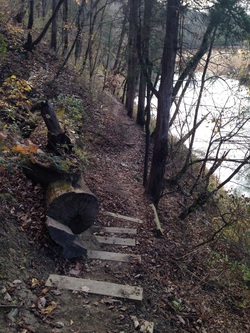 The Narrows of Harpeth The Narrows of Harpeth The 125 mile Harpeth River snakes its way through six counties in Middle Tennessee before it reaches its confluence with the Cumberland River on its way to the Mississippi. Parts of its 870-square-mile watershed comprise the Harpeth River State Park, which is known for its archeological sites and historic landmarks, in addition to its reputation as a popular canoe and kayak destination. Geographically speaking, the Narrows of Harpeth is the most visually stunning and well-known section. The term “Narrows” refers to a point in the river where it circles back to within less than 200 feet of itself as its loops along a narrow wall of limestone. This unusual natural feature inspired 19thcentury businessman Montgomery Bell to build an iron forge, blasting a 290 foot long tunnel, that was 8 feet high and 15 feet wide though the limestone ridge, thus diverting the water for power. Known at the time as the first full-scale water diversion tunnel, the Montgomery Bell Tunnel was considered a revolutionary engineering masterpiece. Because of the world-class steel that was produced at the Pattinson Forge, Bell earned the almost ominous moniker: The Iron Master of Harpeth.
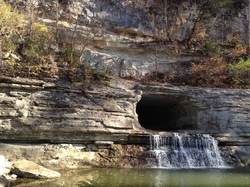 The Montgomery Bell Tunnel The Montgomery Bell Tunnel Today, the tunnel is the only remnant of Bell’s forge, and is now the site of a roughly 2-mile out-and-back that actually consists of three separate trails converging on a single trailhead. To the right is a scenic wooded trail that runs congruent with the northeastern section of the narrows, and even offers a small, albeit out of the way cave for those willing to climb a short, but very steep limestone encrusted hill. The other two trails are both to the left, although, at differing elevations. The descendent trail leads to the remains of the Montgomery Bell Tunnel, while the ascendant is a steep climb to the top of the limestone ridge that offers a striking panoramic of the Harpeth River Valley, which was the etymological inspiration to the 1968 hit song “ Harper Valley PTA,” written by Tom T. Hall. In addition to the Narrows, the Harpeth River State Park is comprised of nine other unconnected access points along the river. While most are simply access ramps for canoeist and kayakers, there are additional trails located at the Hidden Lakes, Newsom’s Mill and Mound Bottom sections. The latter is a Native American archeological site that was inhabited as early as 800 AD, during the Mississippian period. The prehistoric site, which is a complex burial mounds and living quarters, is only accessible by a ranger-led tour.
The Old Forest Offers a Glimpse into the Past 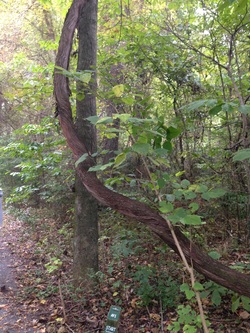 Wild grape vines Wild grape vines If you ever wondered what Memphis looked like 10,000 years ago, just take a trip to Overton Park. Sprawled out across 126 acres, the appropriately named Old Forest stands apart from its urban setting like a portal into the past. Prior to 1901, what is now Overton Park was known as Lea’s Woods—a vast expanse of old growth forest that remained relatively unchanged since the end of the last Ice Age. When park planner George Kessler designed Overton Park he sat aside 172 acres of pristine woodland to be designated as the Old Forest. Since then, the park and the surrounding city have changed greatly, but the forest remains the same. That is unless you know where to look. “The forest is always changing,” Roy Barnes said, as he stops to show a group of day hikers an example of pit-and-mound topography.
Barnes is the president of Citizens to Preserve Overton Park, which is the modern day incarnation of a group that garnered national attention in the early 1970s by halting former U.S. Secretary of Transportation Jim Volpe’s plan to run Interstate 40 through the middle of the park. The Supreme Court case, Citizens to Preserve Overton Park v. Volpe, was landmark case for the conservation of public lands.
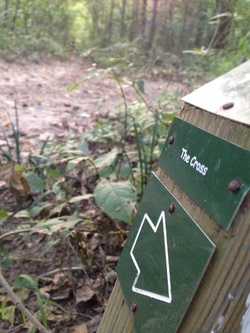 "The Cross" section of the OFT "The Cross" section of the OFT These days the group still protects the park, but now they are more concerned with invasive plant species such as English ivy, or the dreaded kudzu, than Supreme Court rulings. Today, Barnes is leading one of CPOP’s bimonthly nature walks around the Old Forest Trail. While the trails are always open to the public, on the second Saturday and the last Sunday of every month a representative from CPOP leads a 1.5 mile nature walk through the Old Forest to explore the rich biodiversity that inhabits the state natural area. In 2009 the City of Memphis hired Dr. Thomas Heineke to catalogue the flora inside the old growth forest. What he found was nothing short of amazing. “Very few virgin forests exist in the Mid-South region and certainly none within a city the size of Memphis,” Heineke said in his report. “Many of the trees reach heights well over 100 feet and measure four to five feet or larger in diameter at breast height. A large number of these trees are likely greater than 200 years of age.” In his report Heineke catalogued over 70 different species of trees, including 11 species of oak, 332 species of flowering plants from 85 families, two of which, goldenseal and oceanblue phacelia, are on the Tennessee Natural Heritage Program Rare Plant List and an astounding eight different species of wild grape vines, some of which are as old as the trees they cling to.
 Wild mushrooms after a rain Wild mushrooms after a rain “Overton Park Forest is a unique resource which cannot be replaced,” Heineke said. “It is invaluable to the city and to the region as an outstanding example of old growth forest. Because it is within an urban setting, it is even more exceptional. Everything possible should be done to assure that it is protected in perpetuity. This forest is indeed extraordinary and unequaled.”
The Wolf River Trails, an Oasis in the Heart of the City 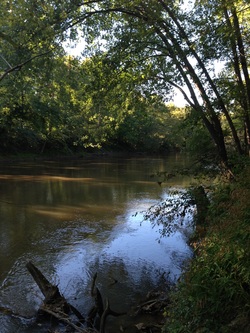 Starting at Baker’s Pond in Benton County, Miss., and meandering though several small towns in North Mississippi and West Tennessee before reaching its confluence with the Mississippi River near Downtown Memphis, the Wolf River and its subsequent watershed provide some 105 miles of textbook bottomland hardwood forest – an indigenous and scenic ecosystem native to the southeast United States. The Wolf River is generally divided into the Upper Wolf and Lower Wolf. The Upper Wolf is extremely popular with canoeists and kayakers for its beautiful scenery and iconic wildlife which include minks, otters, darters and even bald eagles. As a result of the efforts of the Wolf River Conservancy, the Upper Wolf still remains largely unspoiled, and sensitive species like these can survive. The Lower Wolf runs through the middle of Memphis, and as a result it has been channelized, urbanized, dammed and polluted for almost two centuries. However, as a result of the annual flooding, the surrounding area around the river remains undeveloped, and provides a sanctuary for heartier species such as kites, hawks, herons, coyotes, foxes and various reptiles and amphibians to thrive.
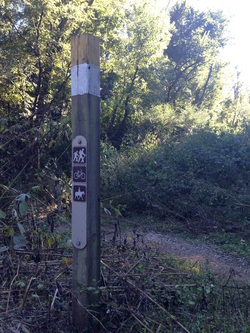 The East Memphis section of the Wolf River provides the backbone for Shelby Farms, which is one of the largest urban parks in the world. Shelby Farms provides park goers with 4,500 acres of lakes, forests, paved and unpaved trails, and other natural areas. The Wolf River Trails wind through the Lucius E. Burch Natural Area south of Walnut Grove Road. The trails can be hiked, biked or ran, and dogs are allowed on leashes. Horseback riding is also allowed in certain parts of the trails. The Wolf River Trails can be traversed as an 8-mile loop, 4-mile loop, or even shorter due the many switchbacks, According to All Trails. The Blue Trail is generally more popular during the spring and summer months due the alluvial nature of the river that sometimes floods the Yellow Trail. However, the more scenic Yellow Trail is more popular in the fall and winter because the BlueTrail tends to remain muddy longer after rain due to the lower elevation and thicker canopy. While it is much more urbanized and generally less pristine than the Upper Wolf, the Wolf River Trails are still a valuable natural resource. Whether it’s an after work trail run to clear your head, or a Sunday nature walk with the family, these trails can provide access to the great outdoors without ever leaving the city limits.
 "Made you smile today"
 "Letters"
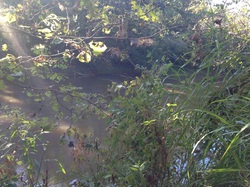 "4 o'clock"
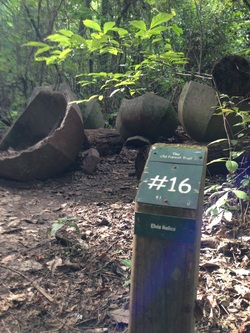 "In your town"
 "The view from here"
 A fitting film reference sets the tone for festival goers walking to the nearby Cooper-Young Festival on Aug. 14, 2013.  Next time you take a drink of Memphis tap water, remember that you are taking a drink of history. “Most people don’t realize that the water MLGW pumps out of the ground in Midtown started off as a rain drop in Fayette County 300 years ago,” Stewart Austin told a group of onlookers at the Cooper-Young Festival. The Cooper-Young Festival started out as a small arts festival, but has grown into the largest single day event in the city. While the focus is still on local artisans selling pricy slices of Americana, many other companies, clubs and associations also purchase booths in order to peddle information. For instance, two enviromental themed groups, The Wolf River Conservancy and Citizens to Preserve Overton Park, manned booths with diagrams, volunteers and pamphlets outlining their causes and highlighting their upcoming events. Citizens to Preserve Overton Park traces its roots back to the 1960s when the group was formed to block the construction of Interstate 40 through Overton Park. They gained national notoriety by taking the case against the Department of Transportation to the Supreme Court-- and winning. Now the group’s main focus is alleviating the parking situation in the park. “It’s time to get creative with a solution, and stop just parking cars in the grass,”said CPOP volunteer Naomi Van Tol. “The zoo doesn’t want to do it, they need an alternative.” Alternatives in the works include a new parking lot inside the zoo’s property and possible shuttles that run from Overton Square to the park courtesy of Bob Loeb. The group also hosts nature hikes along the park's Old Forest Trail on the second Saturday and last Sunday of every month.
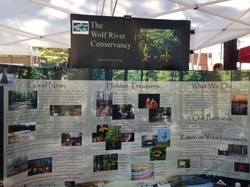 The Wolf River Conservancy is a non-profit land trust working to maintain the Wolf River watershed as a sustainable natural resource. While most Memphians may only be familiar with the section of the river that runs through the Interstate 240 loop, The Wolf River watershed actually covers 522,000 acres and stretches from downtown Memphis to Michigan City, Miss. “We do three things: conservation, recreation and education,” said Stewart Austin, board president for the WRC. Conservation involves protecting the land and the river, recreation refers to the canoe trips, bike rides and nature hikes they sponsor and education pertains to programs designed to use to the river as a teaching tool in the communities and schools. However, the events are available to members only, because the fees make up a large portionof the WRC’s funding. “By joining you are helping us to protect the watershed and the aquifers that supply the city’s drinking water,” said land protection associate Ryan Hall.
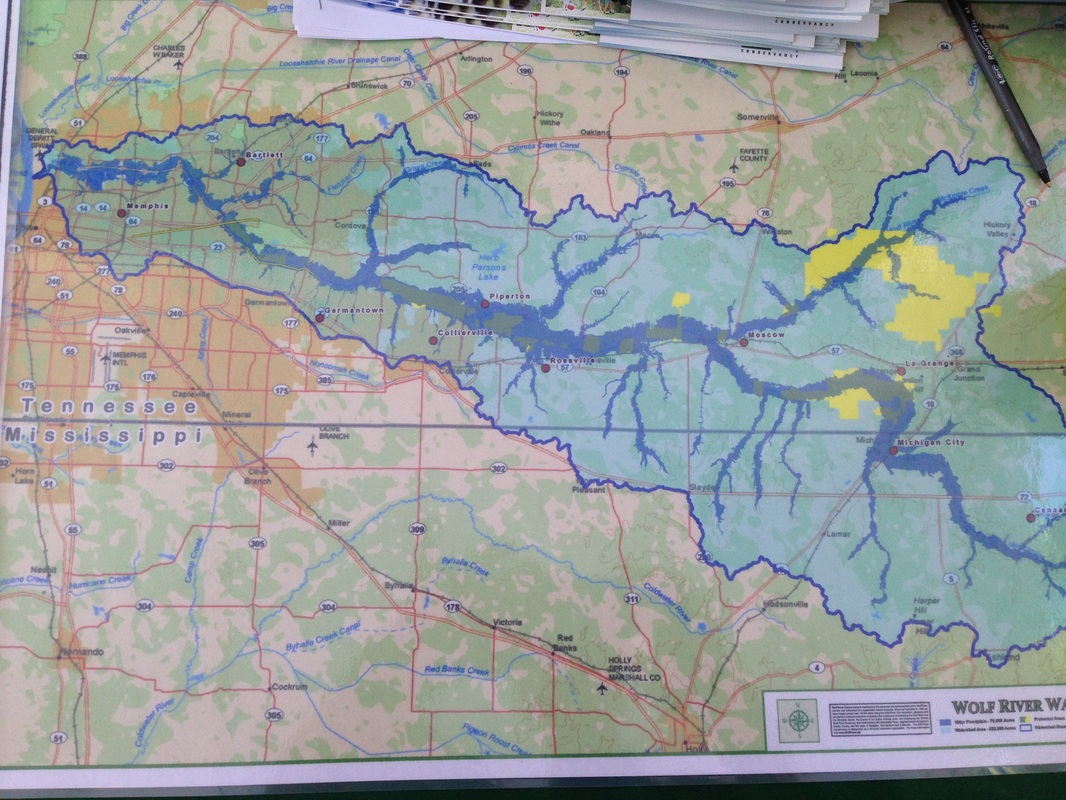 An aerial view of the Wolf River Watershed. The area in blue designates the area in which rainwater drains into the river, which is known as its watershed.
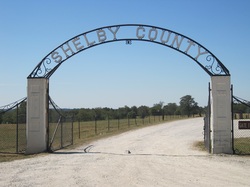 They say every journey begins with a single step. I find this to be a very fitting metaphor for the maiden post of an outdoors blog. When preparing a journey into the great outdoors it’s always best to begin with a checklist, so naturally the best place to begin our lexical journey is with our own checklist of sorts. One of the defining qualities of humanity is our need to explore- our compulsion to push forward into the unknown. This primal quest is so engrained into our being that it still beckons, even in a modern world with very few places left to explore. Modern times may have taken us far from our early hominin ancestry, but our curiosity and desire to explore are still there. Time constraints, schedules and budgets govern our technology driven world, so now more than ever it is important to take some time out, get out and get back to your roots. The Memphis area is home to more natural surprises than most people realize. For example, Shelby Farms is the one of the top 30 largest urban parks
in the world. In this blog, I would like to explore those surprises more in depth, and hopefully help readers reconnect with their roots. And there is no better place to find to roots than in a forest.
|
 Via Brown's Guides
Via Brown's Guides 















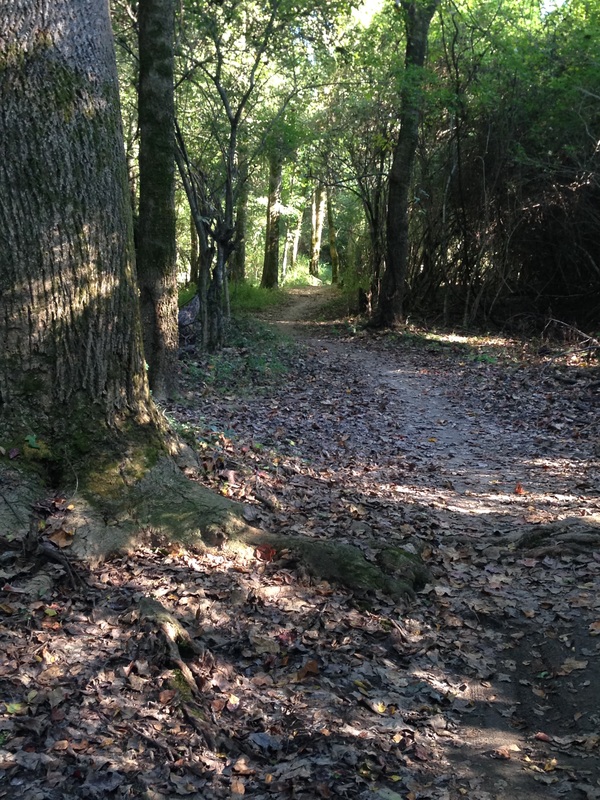










 RSS Feed
RSS Feed